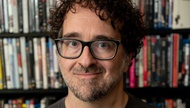Ashley Zabarte used to have a successful jewelry-making business. Her polymer-clay earrings sold well. But after a while, she noticed she was making them for the wrong reasons.
“It started to feel like it wasn’t my work anymore,” she says. “I felt like a factory. … It felt really safe, and it felt like I was making these pieces of jewelry almost out of fear.
“And so I stopped and I started messing around with other mediums.”
With mostly upcycled materials, Zabarte now makes lamps inspired by “strange organic shapes.” She says that decision marked a commitment to nurturing herself as an artist, something she tells other artists to do all the time.
As the owner of the Hey Maker retail store at Fergusons Downtown, she runs a quasi-incubator program that helps artists looking to grow in their craft. “The artists come, and I kind of cater toward their goals,” she says.
In addition to organizing regular markets where artists and crafts makers sell their goods, Zabarte has written guides for artists on topics like e-commerce, how to manage social media and how to sell to a retail shop. “It took me years to really hone that in and figure it out,” she says. “Now, it’s interesting being on the other side of that and being a retailer myself.”
Zabarte took some time out from creating and helping others to talk to the Weekly about her business, handling burnout and thriving in a new medium.
How did Hey Maker start? During the pandemic … May of 2020 … it started as a subscription box, and the whole point of it was to get artwork and curate a space to connect the community with artists.
What’s it like to be an entrepreneur, and how do you deal with the pressure? Entrepreneurship is such a funny thing, especially when it’s a space like this where I can do whatever I want. To be able to focus is sometimes difficult. … With running a business and being an artist, for a long time, I wasn’t nurturing myself as an artist, and it was leading very quickly to burnout. So that’s something that I’ve been working on this year especially—nurturing that side of me, because I am an artist; I am a creative. It always felt too self-serving, but then I realized that if I work as an artist, I can lead by example, too.
What led to your decision to stop making jewelry, and what filled the space? I started the shop, and it was too much to make the earrings and run the shop. And I was getting burned out on the jewelry. … It was a big thing to stop making the jewelry. It felt really brave to say, “I’m not going to be doing this anymore; I want to make weird art.” That’s what I knew I wanted to do—make something from my brain and these really strange organic shapes. I didn’t know what yet. … I couldn’t find the right medium that was satisfying to me.
I went to the hardware store, collected a bunch of garbage and started making these hanging lamps … and then I wanted to make these lamps that look like plants with grow bulbs in them to put near your plant. The only things I’m using that are new are the cords, electrical parts and paint.
Do you feel like you’ve found a more authentic expression in the lamps you’ve been making? I just look at these weirdo things and they make me so happy. It feels like the opposite of when I was making the jewelry. … I think I was afraid that no one would like what was really in my brain. It’s funny, after helping other people and telling people, “Be authentic to you” I finally took my own advice.
How did your advocacy for artists begin? [It] kind of came to me when I was going to school for art at UNLV. I was older than all the other students—I was the professors’ ages. And I saw that all of the artists, all of these young people going to school, have a lot of pressure on them to go this one route to work as an artist, and it wasn’t necessarily a route that would have made them any money and created jobs and space for them to make art as a living.
How do you help artists with their goals and businesses? I do a program for local artists called the Featured Maker program. Sometimes, all the artist needs is help with pricing, [or] they have bigger goals. [With] one of my other Featured Makers, we’re working on grants, and we’re working on art licensing. We’re also working on creating kits.
What I am doing now is what I wish existed when I started. When you’re working as an independent artist, you kind of have to learn as you go. Business-wise, there isn’t a guidebook. So I just try to create something that is accessible and will actually help.
HEY MAKER 1028 E. Fremont St., heymakerandus.com. Wednesday-Sunday, 11 a.m.-5 p.m.
Click HERE to subscribe for free to the Weekly Fix, the digital edition of Las Vegas Weekly! Stay up to date with the latest on Las Vegas concerts, shows, restaurants, bars and more, sent directly to your inbox!




